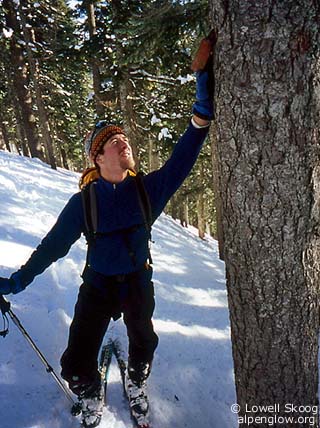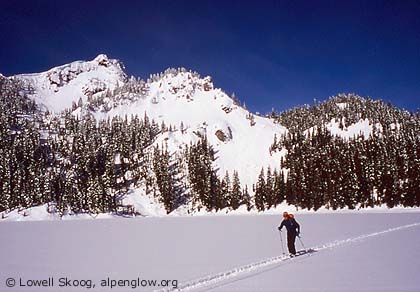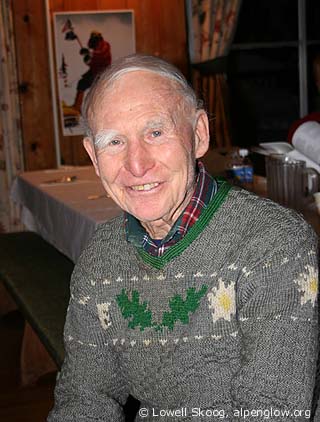

|
| Left: Winners of the inaugural Patrol Race in 1930: (L-R) Hans-Otto Giese, Fred Ball, Andrew W. Anderson (Mountaineers Collection, University of Washington Libraries, Special Collections, neg. 18134). Right: Mountaineers Ski Patrol Trophy, 1936-41, currently held by the Washington Alpine Club. (1931 map, 500kb. 2014 map, 400kb.) |
|
In the Beginning was the Railroad. The first railroad breached the Cascades in 1888 through a tunnel under Stampede Pass. Twenty-seven years later another tunnel was bored under Snoqualmie Pass. A young outdoor club, The Mountaineers of Seattle, realized that the Snoqualmie railroad offered them an opportunity to make their own home in the mountains. So they built a lodge a mile and a half from the tunnel (near Lodge Lake) and began to visit their new home in every season. (This was long before the Snoqualmie Pass highway was open in winter or any ski areas existed at the pass.)
In winter they came on snowshoes. But before long a few started to bring skis. The Mountaineers declared skis to be Good and began using them to explore both north and south from their Lodge. In 1928, a band of Mountaineers spent a weekend in railroad shacks near the Stampede Tunnel to see how this country compared to their home skiing grounds at Snoqualmie. They liked what they found and before the year had ended they built another home, the Meany Ski Hut, near the Stampede Tunnel. Adventurous Mountaineers soon scouted an 18-mile ski route between their two mountain homes. In 1930, they inaugurated a race over this route, the Patrol Race. This race was the first of its kind in North America. Three-man teams would start at intervals from the Snoqualmie Lodge over a trail broken by a party that left before dawn. Each man was required to carry a ten-pound pack of emergency provisions and the three team members had to finish within a minute of each other at the Meany Ski Hut. The race ran for twelve years and produced tales of both misadventure and great ski prowess. (Click here for a map of the course from the 1930s, 500kb.) During World War II, the race was discontinued and in 1944 the old Snoqualmie Lodge burned to the ground. Travel by railroad was supplanted by the automobile, large sections of the Cascade crest between Snoqualmie and Stampede Passes were clear-cut, and skiers turned to groomed trails, chairlifts and slalom. The Patrol Race passed out of memory for all but a few old-time skiers.
When I began researching the history of skiing in Washington, I read many stories about the Patrol Race. During the winter of 2001, when a low snowpack created poor skiing, I scouted the route from both ends on consecutive weekends (see modern map, 400kb). A few weeks later, on a cold, foggy day, I skied the route end-to-end by myself. The following winter I skied it again. I wanted to share the experience of skiing this route with a partner, but due to low interest, schedule conflicts, or bad weather I never hooked up with anybody. In February 2004, I posted a note on turns-all-year.com looking for someone to ski the route on Washington's Birthday. John Mauro called me up. I was a bit nervous about trying the route with an unknown partner, but John came recommended by someone I trust and he enjoys covering distance on skis as much as making turns, a rare quality these days. We hit it off right away. We parked my car at Snoqualmie Summit and started up the groomed slope in the dark at 6 a.m. By the time we reached Beaver Lake, it was getting just light enough to venture into the woods without headlamps. We carefully descended crusty snow to Lodge Lake, the original start of the route. Then we traversed southward, pausing for a moment above the Snoqualmie Tunnel to imagine The Mountaineers, almost ninety years earlier, disembarking from the train to begin their hike through the snow to their Lodge. We followed the Hyak cross-country trails to Windy Pass, then entered the woods northeast of Silver Peak. The section from Windy Pass to Tinkham Pass is my favorite of the route. The old forest is still intact, making it easy to imagine what the entire route was like in the old days. It is also possible to find some of the original route markers, orange colored tin shingles (like large mailbox flags) nailed high on the sides of trees. In April 1933, a party of nine Mountaineers placed over five hundred markers, every three hundred feet or so, along the length of the route so at least one marker in each direction was visible at all times. South of Tinkham Peak, most of the markers were cut down with the great trees that supported them, but north of the peak a few remain.
We reached Tinkham Pass (northeast of the peak) at 10 a.m., a little behind my previous pace due to harder trailbreaking and stops to take pictures of the markers. Then we descended to Mirror Lake, where we encountered our first snowmobile tracks. Except for the tracks, Mirror Lake would have looked unchanged to the pioneers. But once we passed through the trees at the outlet of the lake we entered the Devastation of late twentieth century forestry. As far as the eye could see there were clearcuts and logging roads. We descended to Yakima Pass, then skinned up the clear-cut shoulder south of Twilight Lake to the main Meadow Creek road. All the roads were packed by snowmobiles, and we gave friendly waves whenever they passed us. We schussed down the road for two effortless miles, then took a spur leading up Dandy Creek to a pass one mile northeast of Dandy Pass, known in the old days as Baldy Pass. Here we could look north along Keechelus Lake and see how far we had come. From Baldy Pass we followed the Pacific Crest Trail to Stampede Pass, then followed roads and power lines to the Meany Lodge, arriving at 2:30 p.m. Our time from Snoqualmie Summit to Meany was 8-1/2 hours. For comparison, the record time for the Patrol Race starting at Lodge Lake--about 45 minutes into our tour--by Wolf Bauer, Chester Higman and Bill Miller in 1936 was 4 hours, 37 minutes. Those were rugged days! At Meany we were welcomed by The Mountaineers, who have been operating their little ski area at this site for seventy-five years. The area is a throw-back, a time warp, and thoroughly charming. We rested in the old hut, then accepted a tow behind their tempermental old snowcat to the highway. The Age of the Railroads that gave birth to skiing in the Northwest is long gone, but as John and I bumped along with fifty other skiers behind the old cat, it seemed to me that in this tiny corner of the Cascades the old ski trains are still running.
During the winter of 2005, after I published the preceding story on the World-Wide Web, The Mountaineers contacted me about reviving the Patrol Race. Knowing the history of the event and the intricacies of the route (see detailed description), I recommended conducting this experiment as a guided tour rather than a competitive race. If it was a success, then there might be a future in reviving the race. Unfortunately, the winter of 2005 was a severe snow drought, and the outing was canceled. The Mountaineers contacted me again in 2006, and I agreed to lead the trip. On February 24, 2006, our party of fourteen spent the night at the "new" Mountaineers Snoqualmie Lodge. This lodge was built in 1949 east of the pass (between today's Summit Central and Summit West ski areas) after the original structure at Lodge Lake burned down. Wolf Bauer, Northwest skiing, mountaineering, and kayaking legend, celebrated his 94th birthday by telling us about the early days of the Patrol Race. (Listen to audio recording. See control at left.) Wolf was a member of the 1936 Mountaineers team whose 70-year-old record of 4 hours, 37 minutes has never been beaten. Wolf recalled pranks from the old days, for example slipping rocks into the packs of racers Paul Shorrock and Hans-Otto Giese after the official weigh-in and before the start of the race. He also shared a bit of his life philosophy. "The trick is to die young," he said, "as late as possible." The next morning we set out from the lodge by headlamp at 6 a.m. To avoid poor snow conditions, we decided not to visit Lodge Lake, the original start of the race. Instead, we climbed to the Summit Central crossover trail and followed the divide to the top of the Silver Fir chairlift. This brought us to the Snoqualmie Summit nordic trail system, which we schussed down to Rockdale Lake and climbed up to Olallie Meadow (Windy Pass). This variation bypasses a bit of the historic route, but it is an easier start to the tour. From Windy Pass we picked up the old race route across the flanks of Silver and Tinkham Peaks. The grand old forest extending to Mirror Lake gave us a taste of what the whole route must have been like in the old days. We reached Meany Lodge at 6 p.m., exactly twelve hours after starting. The Mountaineers welcomed us with a hearty dinner. Some of the party hopped the snowcat for home, while the rest of us settled in for a well-earned sleep. It was an enjoyable and memorable trip, made so by great hosts, a great group, and an inspirational visit by Wolf Bauer. Wolf, your record is safe for another year!
This story was originally published in March 2004. On May 12, 2006, the "new" Mountaineers Snoqualmie Lodge burned to the ground. If there was any doubt that our group of fourteen had participated in a once-in-a-lifetime experience, the destruction of the lodge erased it. In 2014, under the leadership of Nigel Steere, the Mountaineers revived the Patrol Race as a competitive (and fun) event. In 2017, the third modern running of the race, my team ("Wet & Scrappy," Seth Davis, Aaron Ostrovsky and myself) finally broke the 1936 Patrol Race record with a time of 4 hours, 19 minutes, and 23 seconds. Our time was recorded over a longer course than the historic race, starting at Snoqualmie Pass. --Lowell Skoog
|
|||||||||||||||||||||||||||||||||||||||||
|
Previous | Next | Overview - Skiing the Cascade Crest | The Alpenglow Gallery |




